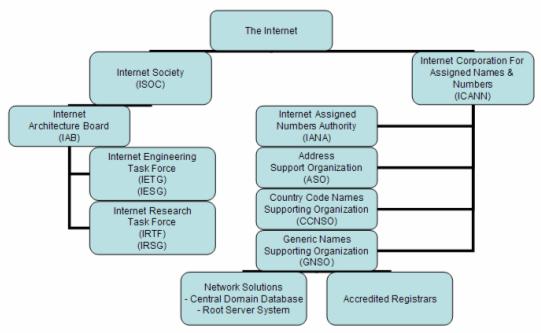|
VI. Conclusions A new system has been described offering much promise in solving many military communications problems. It is, however, a difficult system to understand and further research is necessary in order to achieve sufficient confidence in the notion to permit investment of large sums for its construction. Some paths leading to further examinations of these concepts have been described. The amount of work and its nature is such that it is beyond the scope of work appropriate to RAND. Thus, the majority of the future work will have to come from other organizations and agencies. Now the hard work must begin. Paul Baran, On Distributed Communications, Volume XI, 1964. |
Who manages the Internet? It is often said that there is no central control, administration, or management of the Internet. While this is generally true, there are several well-known organizations that work together in a relatively well structured and roughly democratic environment to collectively participate in the research, development, and management of the Internet, shown with inter-relationships in the chart below.
 |
These Internet management organizations are described in the following sections, where the ASO, CCNSO, and GNSO are part of the ICANN:
Other organizations and procedures that play a role in the management of the Internet are listed below:
- Other Internet Organizations
- W3C — World Wide Web Consortium
- Create A Usenet 8 newsgroup
- Create A Usenet Alt newsgroup
- Find IRC networks
- Find MUD servers
- Find mailing lists.
Historical. The following references provide historical information on Internet management, organizations, and personnel:
- NSF — National Science Foundation — managed the Internet 1990 to 1995
- RFC 1336; Who’s Who in the Internet – Biographies of IAB, IESG and IRSG Members; G. Malkin; May 1992
- RFC 1602; The Internet Standards Process; Internet Architecture Board, Internet Engineering Steering Group; Mar. 1994
- RFC 1603; E. Huizer, D. Crocker; IETF Working Group Guidelines and Procedures; March 1994
- RFC 1871; Addendum to RFC 1602 — Variance Procedure; Jon Postel; Nov. 1995
- RFC 2727; J. Galvin; IAB and IESG Selection, Confirmation, and Recall Process: Operation of the Nominating and Recall Committees; February 2000.